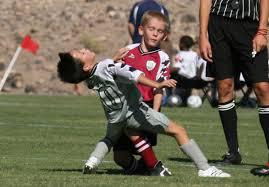
As many as 1.9 million children get concussions from sports and other recreational activities each year, and most of them don’t get checked out by doctors after these injuries, a U.S. study suggests.
Many parents don’t realize “that there are active and early interventions and therapies that can be used to treat kids following a concussion,” said Anthony Kontos, research director of the sports medicine concussion program at the University of Pittsburgh Medical Center.
“There is a misconception among parents that all that can be done with a concussion is rest,” Kontos, who wasn’t involved in the study, said by email. “The fact that kids aren’t being seen by healthcare professionals trained in concussion following this injury is a problem and we need to do a better job of educating parents, coaches and kids of the benefits of seeking appropriate and timely clinical care.”
Researchers analyzed three different nationwide databases to estimate the number of sports and recreation-related concussions. Because not all injuries are reported, and not every child is examined by a health professional, it’s difficult to get an exact count for concussions, the study authors note in the journal Pediatrics.
Still, they estimate that at least 1.1 million children up to age 18 get concussions from sports and recreational activities in the U.S. each year.
And most of these children with concussions – from about 511,000 to 1.2 million – didn’t see healthcare providers after their injuries.
“There are many reasons kids are not seen in healthcare settings for concussions including issues with identification and recognition of concussions and barriers to reporting concussions,” said lead study author Dr. Mersine Bryan of the Seattle Children’s Hospital Research Institute and the University of Washington.
“I do not think it is primarily because concussions are too mild to seek medical care,” Bryan added by email. “If a child has a head injury and is experiencing symptoms afterwards, such as headache, nausea, dizziness, or fatigue, they should be evaluated by healthcare providers.”
Based on the available data, researchers estimate that from about 23 percent to 53 percent of concussions from high school sports aren’t reported to healthcare providers.
Among children who did receive medical care for concussions, about 378,000 got treatment in outpatient clinics, the study found.
An additional 115,000 to 167,000 children got care in emergency departments. Concussions also accounted for between 2,900 and 4,900 hospitalizations.
One limitation of the study is that it’s unclear how many kids with symptoms do actually have concussions, the authors note. It’s also possible that the less complete data on recreational injuries such as falls on the playground may have made it hard to get an accurate estimate for concussions from non-sports activities, the authors said.
Even so, the findings are in line with other research estimating the prevalence of concussions among children, Kontos said.
Because it reviewed previously collected data, the study may have underestimated how common concussions are among children, said Dr. Paul Echlin, a researcher at the Elliott Sports Medicine Clinic in Burlington, Ontario who wasn’t involved in the study.
But even if the concussion rate estimated in the study is imperfect, “we know the incidence rate is epidemic in proportion and unacceptable,” Echlin said by email.
Source: Reuters
 FR
FR EN
EN AR
AR








